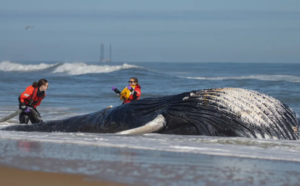
By David Wojick
In formal comments, the Committee for a Constructive Tomorrow (CFACT) has asked the U.S. Environmental Protection Agency to assess the adverse impact of the giant Virginia offshore wind project on air and water quality. The issue is far-reaching because all big offshore wind facilities could have these adverse effects.
Despite reporting that the approval process for Dominion Energy Virginia’s Coastal Virginia Offshore Wind project is done, yet another necessary permit process and comment period is underway. Construction is moving ahead, however, and now the onshore transmission lines project is starting to stir concerns in neighborhoods.
CFACT points to three specific impacts, two of which come from what are called the “wake effects” of operational offshore wind facilities. Both effects have been observed and modeled in large European offshore operations. I discuss these wake effects here.
The first effect CFACT calls the reduced energy air plume. They explain it this way:
The wake effect is the well-established fact that the air flow downwind of an operating wind turbine has significantly less energy than the air flow upwind. This is because the turbine’s job is to remove energy from the air flow, converting it into electricity. By some estimates, 50% of the energy is removed.
The Virginia offshore wind facility is removing energy from a 150-square-mile area, thus creating a massive reduced energy plume. The adverse impact is that this plume could increase the ozone levels in nearby urban areas. Ozone flourishes in low energy air.
Immediately onshore from the Virginia wind facility lies the city of Virginia Beach. This sounds like a little tourist town, but it is, in fact, Virginia’s biggest city. It is half again bigger than Pittsburgh.
Virginia Beach is presently in compliance with the EPA ozone standard, but not by much, so the adverse impact of the offshore wind-reduced energy plume is a serious concern. This will be a concern for other coastal urban areas that are onshore of big wind facilities. EPA should be required to take a hard look at this potential impact of reduced energy air on ozone compliance.
The second wake effect is, in a way, the opposite in that there is too much energy. Each wind tower causes turbulence in both the air flow and the water currents as they pass by. This turbulent energy disturbs the sea floor so much that it creates a suspended sediments plume that flows with the current.
Here again, we are talking about a 150-square-mile plume generator, so the result could be massive. There is a large body of scientific literature on the potential adverse impact of these sediment plumes on marine life.
CFACT points out that EPA appears to be ignoring this serious impact in violation of the Clean Water Act. An impact of this magnitude should require a permit under the CWA, but no such permit has been made public.
Perhaps it has not occurred to EPA to apply the CWA to offshore wind facilities. But it should. The law applies to the “navigable waters” of the US. The Virginia facility is certainly in navigable waters, as several shipping lanes have to be rerouted around it. All the offshore wind facilities presently in development had better be in US waters as the Feds are collecting billions in lease payments for them.
At this point CFACT is merely raising the question, why isn’t the Clean Water Act employed in offshore wind industrialization?
The third issue CFACT raises is technological. EPA is considering issuing an air quality permit for the construction and operation of the Virginia facility. Their primary concern is the exhaust emissions from the huge number of boat trips involved.
CFACT points out that other countries are starting to use electric boats in order to avoid these emissions. In fact, there are service boats specifically designed to be charged directly from the wind facility’s output.
The Clean Air Act requires EPA to call for the best available control technology. Electric boats would seem to fit this requirement, and the firms employed in carrying out this construction should be required to deploy them.
Given these facts, it appears the EPA has not been doing a proper job of offshore wind impact assessment and permitting under both the Clean Air and Clean Water Acts.
David Wojick, Ph.D. is an independent analyst working at the intersection of science, technology and policy. He has been on the faculty of Carnegie Mellon University and the staffs of the U.S. Office of Naval Research and the Naval Research Lab. This article was originally published at cfact.org.

Leave a Reply
You must be logged in to post a comment.